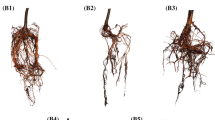Summary
Four types of reaction of Chrysanthemum morifolium to infection by Puccinia horiana are described. (1) Resistant plants show no macroscopic lesions. Cultivars classified as resistant carry a single dominant gene mostly in a simplex, sometimes in a duplex condition. (2). Incomplete resistance provides good protection but under extreme test conditions some pustules develop slowly. (3) Necrosis inhibits spore formation to a large extent. The progenies of crosses between necrotic and susceptible cultivars are mostly susceptible. (4) Susceptible plants sporulate abundantly.
The merits of the three types of resistance are discussed.
Similar content being viewed by others
References
Dickens, J. S. W., 1971. Further observations on the resistance of Chrysanthemum cultivars to white rust (Puccinia horiana Henn.). P1. Path. 20: 27–28.
Dowrick, G. I., 1953. The chromosomes of Chrysanthemum. II: Garden varieties. Heredity 7: 59–72.
Endo, N., 1969. The chromosome survey on the cultivated Chrysanthemum, Chrysanthemum morifolium Ram. I: On the chromosome numbers of cultivated Chrysanthemum. (part 1). J. Japan. Soc. Hort. Sci. 38: 267–274.
Eskes, A. B., 1983. Expression of incomplete resistance to pathogens. in: In: Lamberti, F., J. M., Waller & N. A.Van Der, Graaf (Eds), Durable resistance in crops. Plenum press, New York. p. 169–196.
Firman, I. D. & P. H., Martin, 1968. White rust of Chrysanthemum. Ann. Appl Biol. 62: 429–442.
Langton, F. A., 1980. Chimerical structure and carotenoid inheritance in Chrysanthemum morifolium (Ramat.). Euphytica 29: 807–812.
Martin, P. H. & I. D., Firman, 1970. Resistance of Chrysanthemum cultivars to white rust (Puccinia horiana). P1. Path. 19: 180–184.
Niks, R. E. & H. J. Kuiper, 1982. Histology of the relation between minor and major genes for resistance of barley to leaf rust. Phytopathology 72:
Parlevliet, J. E., 1979. Components of resistance that reduce the rate of epidemic development. Ann. Rev. Phytopathol. 17: 203–222.
Russell, G. E., 1978. Plant breeding for pest and disease resistance. Butterworths, London, 485 pp.
Van Der, Plank, J. E., 1968. Disease resistance in plants. Academic Press, New York & London, 206 pp.
Watanabe, K., 1977. The control of diploid-like meiosis in polyploid taxa of Chrysanthemum (Compositae). Japan. J. Genetics 52: 125–131.
Watanabe, K., 1983. Studies on the control of diploid-like meiosis in polyploid taxa of Chrysanthemum. Tag 66: 9–14.
Yamaguchi, T., 1981. Chrysanthemum breeding for resistance to white rust. Japan. J. Breed. 31: 121–132.
Author information
Authors and Affiliations
Rights and permissions
About this article
Cite this article
De Jong, J., Rademaker, W. The reaction of Chrysanthemum cultivars to Puccinia horiana and the inheritance of resistance. Euphytica 35, 945–952 (1986). https://doi.org/10.1007/BF00028604
Received:
Issue Date:
DOI: https://doi.org/10.1007/BF00028604



